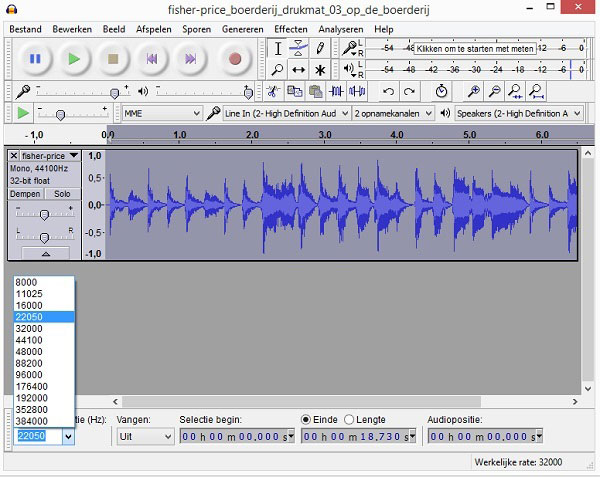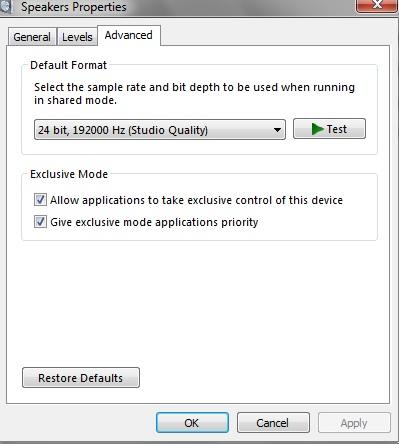

- Vt3 wasapi sample rate drivers#
- Vt3 wasapi sample rate driver#
- Vt3 wasapi sample rate pro#
- Vt3 wasapi sample rate professional#
- Vt3 wasapi sample rate windows#
Some device drivers will report that they support a 1-channel or 2-channel PCM format if the format is specified by a stand-alone WAVEFORMATEX structure, but will reject the same format if it is specified by a WAVEFORMATEXTENSIBLE structure.

For exclusive-mode formats, the method queries the device driver. For shared-mode formats, the method queries the audio engine to determine whether it supports the specified format. The caller must specify whether the stream format is intended for use in shared mode or in exclusive mode. The IsFormatSupported method indicates whether an audio endpoint device supports a particular stream format. The method always uses a WAVEFORMATEXTENSIBLE structure, instead of a stand-alone WAVEFORMATEX structure, to specify the format. The GetMixFormat method retrieves the stream format that the audio engine uses for its internal processing of shared-mode streams. The following WASAPI methods use the WAVEFORMATEX and WAVEFORMATEXTENSIBLE structures to describe stream formats: For information about the new structure, see Representing Formats for IEC 61937 Transmissions. Starting with Windows 7, the WAVEFORMATEXTENSIBLE has been extended to represent device formats for transmitting encoded audio over an IEC 61937-compatible interface.

Vt3 wasapi sample rate windows#
In contrast, the WAVEFORMATEXTENSIBLE structure can specify both the mapping of channels to speakers and the number of bits of precision in each sample.įor more information about WAVEFORMATEX and WAVEFORMATEXTENSIBLE, see the Windows DDK documentation. In addition, although WAVEFORMATEX specifies the size of the container for each audio sample, it cannot specify the number of bits of precision in a sample (for example, 20 bits of precision in a 24-bit container). By itself, a WAVEFORMATEX structure cannot specify the mapping of channels to speaker positions. The contents of a WAVEFORMATEX structure indicate whether it is a stand-alone WAVEFORMATEX structure or part of a WAVEFORMATEXTENSIBLE structure.Ī stand-alone WAVEFORMATEX structure can adequately describe a format with one or two channels and a sample size that is a multiple of 8 bits. The first member of the WAVEFORMATEXTENSIBLE structure is a WAVEFORMATEX structure. Any format that can be described by a stand-alone WAVEFORMATEX structure can also be described by a WAVEFORMATEXTENSIBLE structure. A WAVEFORMATEXTENSIBLE structure is effectively a WAVEFORMATEX structure that has been extended to describe a greater range of formats. WASAPI uses a WAVEFORMATEX or WAVEFORMATEXTENSIBLE structure to specify a stream format.
Vt3 wasapi sample rate driver#
The white paper titled "Audio Driver Support for the WMA Pro-over-S/PDIF Format" at the Audio Device Technologies for Windows website.The description of the WAVE_FORMAT_WMA_SPDIF wave-format tag in the Windows DDK documentation.
Vt3 wasapi sample rate pro#
For more information about using WMA Pro streams over S/PDIF, see the following documentation:

Vt3 wasapi sample rate professional#
An example of a fixed-rate non-PCM format is a 48-kHz Windows Media Audio Professional (WMA Pro) audio stream that passes through a Sony/Philips digital interface (S/PDIF) link in digital form without being decoded. In addition, only non-PCM formats with fixed data rates are supported in exclusive mode. Thus, only exclusive-mode streams can have non-PCM formats. However, the audio engine can mix only PCM streams. Many audio devices support both PCM and non-PCM stream formats. In exclusive mode, the application and device exchange audio data directly, without intervention by the audio engine. If an application is using a device in exclusive mode, the application must use a stream format that the audio hardware explicitly supports. However, the format for an application stream typically must have the same number of channels and the same sample rate as the stream format used by the device. The audio engine can convert between a standard PCM sample size used by the application and the floating-point samples that the engine uses for its internal processing. Thus, applications that use the core audio APIs to play or record audio streams might be required to do some or all of the conversions between stream formats.Īn application that uses WASAPI to manage shared-mode streams can rely on the audio engine to perform only limited format conversions. In contrast, the core audio APIs are more restrictive because they require application streams to use formats that are the same as, or are closely related to, the formats used by the device. For an audio application, a benefit of using a higher-level audio API, such as DirectSound or the Windows multimedia waveOutXxx functions, is that the API automatically converts between the stream formats used by the application and the formats used by the audio device.


 0 kommentar(er)
0 kommentar(er)
